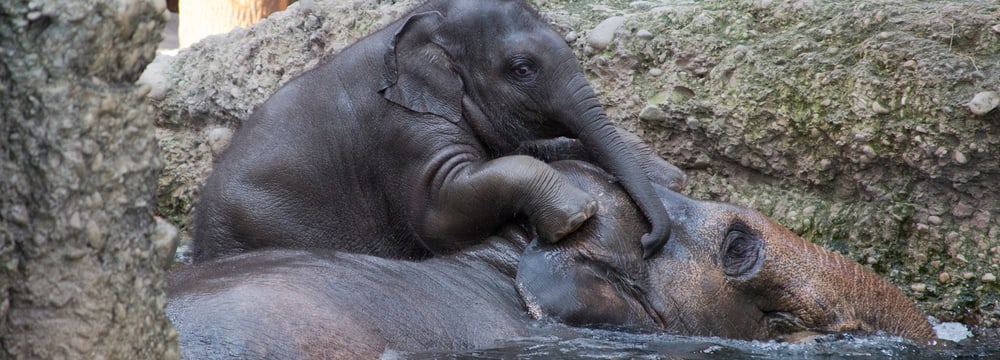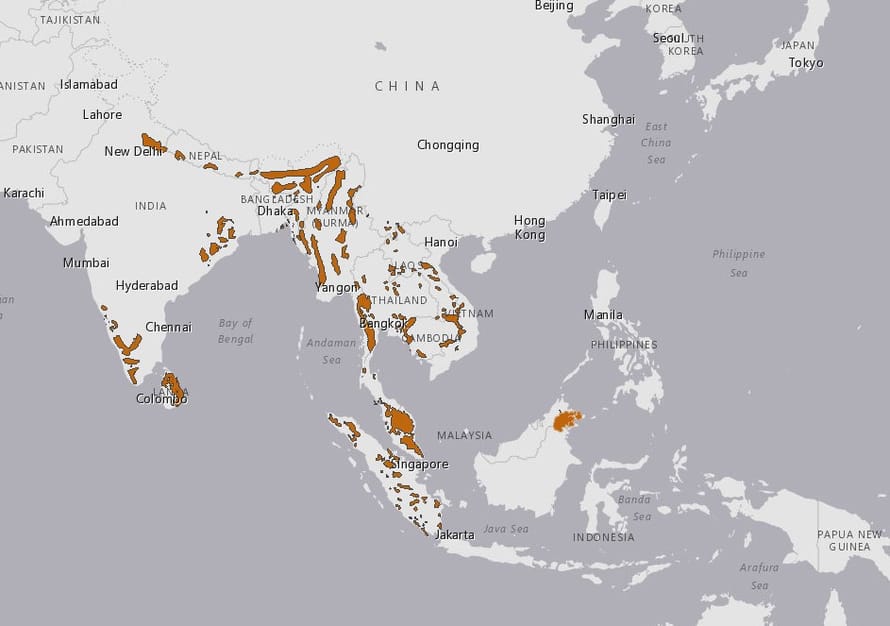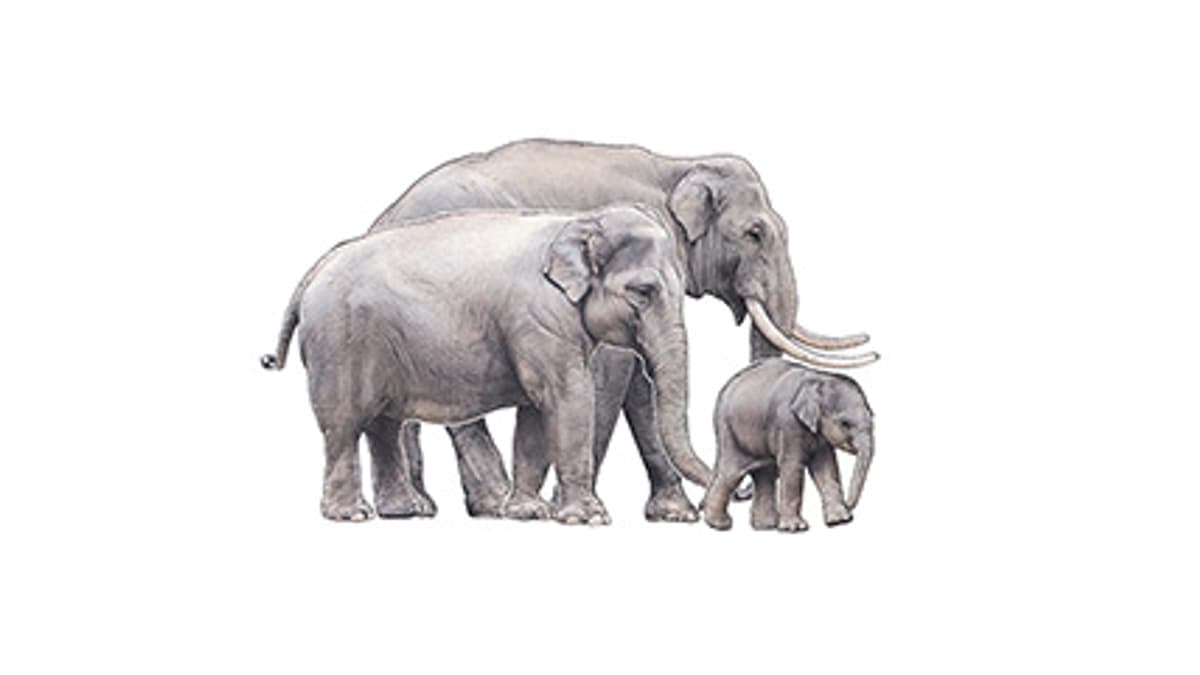
Asian elephant
Elephas maximus
Elephants love water. They are good and tenacious swimmers. To do this, the elephants move all four legs at the same time. Their massive body gives them sufficient buoyancy. Their face is usually above the surface of the water, while their mouth is in the water. They use their trunk as a snorkel so that they can breathe. In the wild, the swimming elephants of the Andaman Islands, which belong to India, are particularly well known. Sometimes elephants leave one island and swim several kilometers through the Andaman Sea to reach another. Elephants have a complex skin care routine that takes a lot of time. This involves bathing, wallowing, massaging and powdering the body with dust to get rid of the annoying parasites in the skin folds.
Their large ears, which are well supplied with blood, are used for heat regulation, because elephants are not very adept at regulating their body temperature. For example, they have no actual sweat glands and therefore cannot perspire. Therefore they are forced to look for shade in the heat, to bathe or swim in the water or to fan themselves with their ears. In the large ears there are extensive blood vessels in which the warm blood can cool down a little when fanning / waggling.
“Positive Reinforcement Training": This management of the elephants is based on the animals and is voluntary. For example, if the vet wants to inspect a part of the body more closely, the animal has to come to a certain point in the enclosure or to a stable. Protected by strong fencing, the vet can even touch the relevant part of the body. In order for the animal to do this voluntarily, it needs prior training. The aim is to encourage a desired behavior, for example going to a certain point in the enclosure, using a positive response from the animal’s perspective from the animal care team. The animals are rewarded for "correct" behavior. Unwanted behavior is ignored. It is important that the elephant likes the training because otherwise it will not take part. The elements of so-called "positive reinforcement training" are a request from the animal carer to ultimately reward a reaction from the animal to a click or a whistle, which marks the exact fulfillment of the command at the right moment, by giving a treat. In addition to the clicking noise or whistle, a stick, called a target, is usually also used as a guide for the animals. This makes it easier for the animal to understand what is being asked of it.
The elephant first learns to touch the stick with different parts of the body or to follow it. The stick can later be used to bring the animal into a desired position, in particular to simplify the work of the veterinarian or animal nurse. "Positive reinforcement training" is used at Zoo Zürich with other species as well.
| Related to | Afrotheria, proboscideans, elephants (3 species), Asian elephant (3 or 4 subspecies) |
| Habitat | Dry forest, rainforest, scrub forest and grassland |
| Mode of life | Active during the day, although predominantly crepuscular and nocturnal outdoors, prefers to rest in the shade during the day |
| Social structure | Herd with related adult females and their calves, males in small groups or as solitary animals |
| Diet | Up to 150 kg daily, made up of fresh grass and hay, leaves, twigs and branches, bark, fruits, in zoos also carrots and beetroot |
| Weight | Females up to 4,600 kg, males up to 6,000 kg, newborns around 100 kg |
| Body height | 3.4 m (maximum shoulder height) |
| Head to torso length | Up to 5 m |
| Tail length | Up to 1,5 m |
| Gestation time | Between 630 and 690 days |
| Litter size | 1 young, rarely twins |
| Age of sexual maturity | Between 15 and 17 years, younger in zoos |
| Life expectancy | Between 50 and 60 years, up to 69 years in zoos |
| Commerce | Tusks (ivory), meat, leather, as work and riding animals, and in cultural and religious ceremonies as so-called temple elephants |
| Population trend | Maximum of 40,000 animals, of which 20,000 in India, 4,000 each in Burma and Sri Lanka, in European zoos: 78 males and 160 females in 71 zoos (as of 2020) |
| At Zurich Zoo since | 1929 next to the former main building (today’s penguin enclosure), from 1971 to 2014 in an elephant house with outdoor enclosure (today’s Mongolian steppe), from 2014 in the Kaeng Krachan Elephant Park, a total of 9 young, internationally coordinated breeding (EEPs) |
Distribution

Amount of food per day
- Hay freely available
- 6 kg of elephant cubes
- 3 kg of vegetables and fruits (carrots, beetroot or fodder beet, cauliflower, celery, fennel, leek, apples)
- Feed branches to nibble on
- 100 g of cattle salt
- Water freely available
Our elephants
Thai
Ceyla-Himali
Panang
Farha
Indi
Chandra
Our commitment to wild elephants
Our exhibition on the topic
Asian elephant (YouTube playlist)
Animal sound
Sponsors
| INDI | in memoriam H. Bär-Wolff-Limper |
| THAI | Preisig AG, Zürich |
| CEYLA-HIMALI | in memoriam R. + R. Schlageter, Zollikon |
| THAI | M. Wirth-Wolff, Zürich |
| FARHA | Schlageter-Hofmann Stiftung |
| CHANDRA | Lüscher Gartenbau-Baumschulen AG, Zürich |
| PANANG | Schlageter-Hofmann Stiftung |


